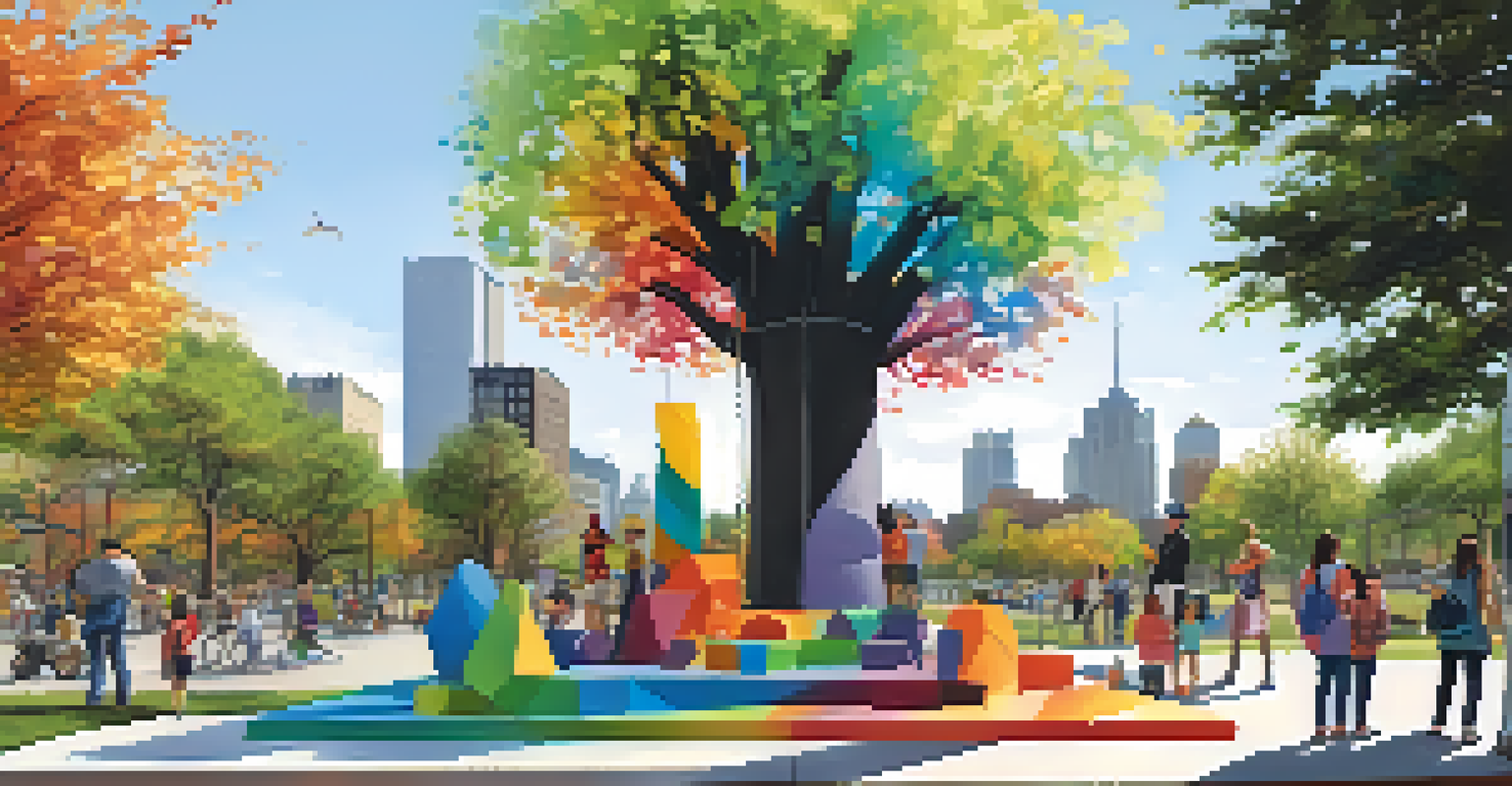The Role of Public Art in Shaping Utah's Urban Landscape

Understanding Public Art and Its Significance
Public art encompasses a variety of artistic expressions displayed in public spaces, from murals to sculptures. It serves as a visual representation of a community's culture, values, and history. By making art accessible to all, it fosters a sense of belonging and pride among residents.
Public art is a way to bring communities together, to express their identity and engage in conversations that matter.
In Utah, public art plays a crucial role in shaping the urban landscape, offering more than just aesthetic appeal. It invites conversations, inspires creativity, and encourages community engagement. This art form often reflects local issues, celebrating diversity and stimulating dialogue.
Moreover, public art can be a catalyst for social change, prompting viewers to reflect on their surroundings. Through its presence, it transforms mundane spaces into vibrant environments, making the city more inviting. Ultimately, public art enhances the quality of life for residents and visitors alike.
The Evolution of Public Art in Utah
Utah's public art scene has evolved significantly over the years, mirroring the growth of its communities. Initially, art in public spaces was limited, but as cities expanded, so did the need for artistic representation. Today, local governments and organizations actively support public art initiatives.

For instance, the Salt Lake City Public Art Program has been instrumental in commissioning works that resonate with the community. This evolution has not only beautified urban areas but also created a sense of identity for neighborhoods. Art installations now often celebrate Utah's unique heritage and natural landscapes.
Public Art Enhances Community Identity
Public art reflects and celebrates the unique culture, values, and history of Utah's diverse communities.
As public art continues to evolve, it increasingly involves community input and collaboration. Artists are now more attuned to the needs and stories of the communities they serve. This engagement fosters a deeper connection between the art and its audience, making each piece a reflection of collective experiences.
Public Art as a Tool for Community Engagement
One of the most powerful aspects of public art is its ability to engage communities. Interactive installations, for example, invite participation, allowing residents to become part of the artwork. This involvement not only enriches the experience but also fosters a sense of ownership and pride.
Art enables us to find ourselves and lose ourselves at the same time.
Events such as art walks and community workshops further encourage collaboration between artists and residents. These initiatives create opportunities for learning and personal expression, helping to build connections among diverse groups. As a result, public art becomes a shared experience that unites rather than divides.
Moreover, public art can spark dialogue about important social issues within the community. By reflecting local struggles and triumphs, these artworks can resonate deeply, encouraging discussions that lead to positive change. In this way, public art serves as a mirror, reflecting the community's aspirations and challenges.
Economic Impact of Public Art in Urban Areas
The presence of public art can significantly impact local economies, attracting both residents and tourists. Vibrant murals and sculptures often become landmarks, drawing visitors who contribute to local businesses. This influx can lead to job creation and increased revenue for the area.
Additionally, public art initiatives often involve local artists, fostering a creative economy. By investing in artists, cities can stimulate innovation and attract creative talent. This not only enhances the cultural scene but also positions the city as a hub for artistic endeavors.
Economic Benefits of Public Art
Public art attracts visitors, boosts local economies, and increases property values by enhancing the aesthetic appeal of neighborhoods.
Furthermore, studies have shown that neighborhoods with public art experience higher property values. The aesthetic enhancement of an area can lead to increased demand for housing and commercial spaces. Thus, public art not only beautifies but also serves as a smart economic strategy for urban development.
Challenges Facing Public Art in Utah
Despite its benefits, public art in Utah faces several challenges. Funding can be a significant hurdle, as many projects rely on grants and donations. In times of economic uncertainty, art budgets are often among the first to be cut, jeopardizing future initiatives.
Moreover, the process of selecting and installing public art can be fraught with controversy. Community members may have differing opinions on what constitutes art, leading to disagreements about specific projects. These discussions, while valuable, can delay the implementation of new pieces.
Lastly, maintaining public art poses its own set of challenges. Weather, vandalism, and general wear and tear can diminish the quality of installations over time. Ongoing maintenance and restoration efforts are crucial to ensure that these artworks continue to inspire and engage the community.
Public Art and Cultural Identity in Utah
Public art serves as a canvas for expressing Utah's rich cultural identity. From the iconic imagery of the Great Salt Lake to representations of Native American heritage, these artworks tell the stories of the land and its people. They reflect the unique blend of cultures that coexist in the state.
Moreover, public art can help preserve history, capturing moments that define a community. Murals may depict significant historical events or figures, ensuring that these stories remain alive for future generations. In this way, public art acts as a bridge between past and present.
Challenges in Public Art Funding
Public art initiatives in Utah face funding challenges, selection controversies, and maintenance issues that can hinder their success.
As Utah continues to grow and diversify, public art will play an essential role in shaping its cultural landscape. By embracing a variety of artistic expressions, communities can celebrate their differences while fostering unity. This commitment to inclusivity in public art enriches the urban experience for everyone.
The Future of Public Art in Utah's Urban Landscape
Looking ahead, the future of public art in Utah is promising and filled with potential. As technology evolves, artists are incorporating new mediums, such as augmented reality, into their work. This innovation can create dynamic, interactive experiences that engage audiences in unprecedented ways.
Additionally, there is a growing recognition of the importance of public art in urban planning. Cities are increasingly prioritizing artistic initiatives in their development strategies. This shift is not just about beautification but also about enhancing community well-being and cultural vitality.

Finally, ongoing collaboration between artists, city officials, and community members will be key to the success of future public art projects. By prioritizing inclusivity and dialogue, Utah can continue to foster a vibrant urban landscape that celebrates its rich cultural tapestry. The evolution of public art will undoubtedly remain a vital aspect of Utah's identity.